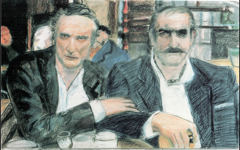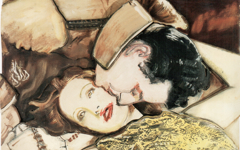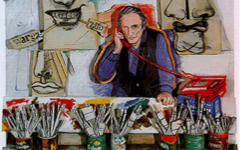Larry Rivers’ Déjà vu and the Red Room: Double Portrait of Matisse (1996)
Larry Rivers’ 1996 variation on Matisse’s 1908 Red Harmony is an instructive essay (visual, of course) on how to interpret a great masterpiece.
Just as we show elsewhere that Matisse’s maid is an alter ego of Matisse so here, in Rivers’ variation, the maid becomes an alter ego of Rivers.
Click next thumbnail to continue

Detail of Matisse's Harmony in Red; detail of Rivers' Deja Vu; photo of Rivers
Click image to enlarge.
Study the three heads (from left: Matisse’s maid, Rivers’ maid and a photo of Rivers) to see how the American artist ever so subtly changed his copy of the maid’s nose to suggest his own hooked proboscis while altering her hair-do to resemble his as well. In eliminating the high collar of the maid’s dress, he also suggested the familiar V-neck of the black T-shirt he so often wore when painting.
Click next thumbnail to continue
There can be no doubt, then, that Rivers’ maid is Rivers. Thus, in placing an image of the real Matisse behind the maid, who is the alter ego of both Matisse and Rivers, Rivers creates the Double Portrait of Matisse in his title. He both cites Matisse as his inspiration and seems to claim for himself some kind of artistic descent from the earlier master.
Click next thumbnail to continue
Fully aware that Matisse’s original (at left) is an image of Matisse’s studio in Matisse’s mind, Rivers also changed the apparent view through the window to one of Matisse’s actual paintings, The Dance.
Click next thumbnail to continue
Lastly, it may be significant that Rivers changed all the blue vines and flowers in the tablecloth and wall to green, the color of fertility. There is a possibility that he recognized Matisse’s eyes behind the two large flowers near the lower edge. (See Matisse’s Red Harmony) If he did and Rivers' eyes were green (though I do not know their color) the change would further support this reading.
NB. If anybody remembers the color of Rivers’ eyes, please let me know.
See note below
For a related painting see Matisse's Still-Life with Dance (1909); and for another example of a maid as an artist, see Manet’s Olympia.
More Works by Rivers
Notes:
Original Publication Date on EPPH: 26 Jul 2010. | Updated: 0. © Simon Abrahams. Articles on this site are the copyright of Simon Abrahams. To use copyrighted material in print or other media for purposes beyond 'fair use', you must obtain permission from the copyright owner. Websites may link to this page without permission (please do) but may not reproduce the material on their own site without crediting Simon Abrahams and EPPH.







